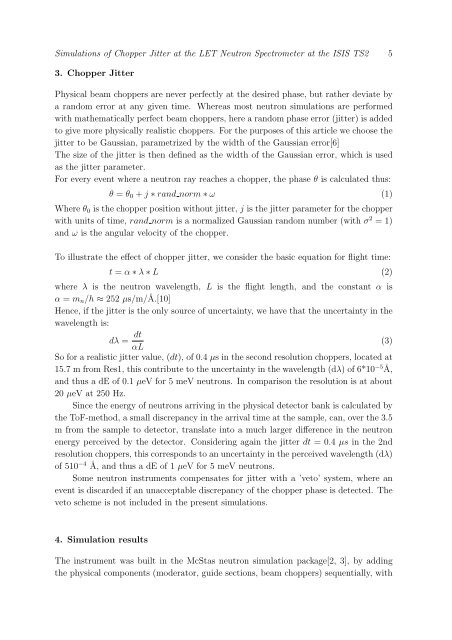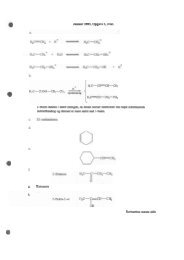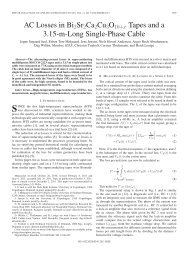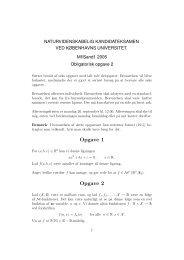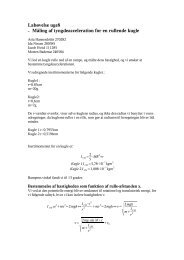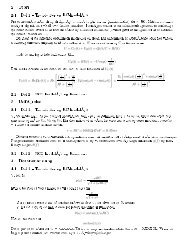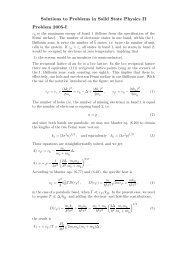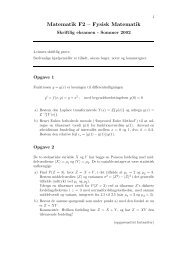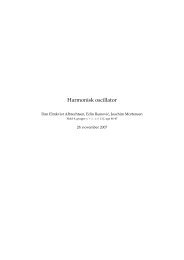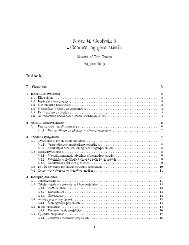Simulations of Chopper Jitter at the LET Neutron Spectrometer at the ...
Simulations of Chopper Jitter at the LET Neutron Spectrometer at the ...
Simulations of Chopper Jitter at the LET Neutron Spectrometer at the ...
You also want an ePaper? Increase the reach of your titles
YUMPU automatically turns print PDFs into web optimized ePapers that Google loves.
<strong>Simul<strong>at</strong>ions</strong> <strong>of</strong> <strong>Chopper</strong> <strong>Jitter</strong> <strong>at</strong> <strong>the</strong> <strong>LET</strong> <strong>Neutron</strong> <strong>Spectrometer</strong> <strong>at</strong> <strong>the</strong> ISIS TS2 53. <strong>Chopper</strong> <strong>Jitter</strong>Physical beam choppers are never perfectly <strong>at</strong> <strong>the</strong> desired phase, but r<strong>at</strong>her devi<strong>at</strong>e bya random error <strong>at</strong> any given time. Whereas most neutron simul<strong>at</strong>ions are performedwith m<strong>at</strong>hem<strong>at</strong>ically perfect beam choppers, here a random phase error (jitter) is addedto give more physically realistic choppers. For <strong>the</strong> purposes <strong>of</strong> this article we choose <strong>the</strong>jitter to be Gaussian, parametrized by <strong>the</strong> width <strong>of</strong> <strong>the</strong> Gaussian error[6]The size <strong>of</strong> <strong>the</strong> jitter is <strong>the</strong>n defined as <strong>the</strong> width <strong>of</strong> <strong>the</strong> Gaussian error, which is usedas <strong>the</strong> jitter parameter.For every event where a neutron ray reaches a chopper, <strong>the</strong> phase θ is calcul<strong>at</strong>ed thus:θ = θ 0 + j ∗ rand norm ∗ ω (1)Where θ 0 is <strong>the</strong> chopper position without jitter, j is <strong>the</strong> jitter parameter for <strong>the</strong> chopperwith units <strong>of</strong> time, rand norm is a normalized Gaussian random number (with σ 2 = 1)and ω is <strong>the</strong> angular velocity <strong>of</strong> <strong>the</strong> chopper.To illustr<strong>at</strong>e <strong>the</strong> effect <strong>of</strong> chopper jitter, we consider <strong>the</strong> basic equ<strong>at</strong>ion for flight time:t = α ∗ λ ∗ L (2)where λ is <strong>the</strong> neutron wavelength, L is <strong>the</strong> flight length, and <strong>the</strong> constant α isα = m n /h ≈ 252 µs/m/Å.[10]Hence, if <strong>the</strong> jitter is <strong>the</strong> only source <strong>of</strong> uncertainty, we have th<strong>at</strong> <strong>the</strong> uncertainty in <strong>the</strong>wavelength is:dλ = dt(3)αLSo for a realistic jitter value, (dt), <strong>of</strong> 0.4 µs in <strong>the</strong> second resolution choppers, loc<strong>at</strong>ed <strong>at</strong>15.7 m from Res1, this contribute to <strong>the</strong> uncertainty in <strong>the</strong> wavelength (dλ) <strong>of</strong> 6*10 −5 Å,and thus a dE <strong>of</strong> 0.1 µeV for 5 meV neutrons. In comparison <strong>the</strong> resolution is <strong>at</strong> about20 µeV <strong>at</strong> 250 Hz.Since <strong>the</strong> energy <strong>of</strong> neutrons arriving in <strong>the</strong> physical detector bank is calcul<strong>at</strong>ed by<strong>the</strong> ToF-method, a small discrepancy in <strong>the</strong> arrival time <strong>at</strong> <strong>the</strong> sample, can, over <strong>the</strong> 3.5m from <strong>the</strong> sample to detector, transl<strong>at</strong>e into a much larger difference in <strong>the</strong> neutronenergy perceived by <strong>the</strong> detector. Considering again <strong>the</strong> jitter dt = 0.4 µs in <strong>the</strong> 2ndresolution choppers, this corresponds to an uncertainty in <strong>the</strong> perceived wavelength (dλ)<strong>of</strong> 510 −4 Å, and thus a dE <strong>of</strong> 1 µeV for 5 meV neutrons.Some neutron instruments compens<strong>at</strong>es for jitter with a ’veto’ system, where anevent is discarded if an unacceptable discrepancy <strong>of</strong> <strong>the</strong> chopper phase is detected. Theveto scheme is not included in <strong>the</strong> present simul<strong>at</strong>ions.4. Simul<strong>at</strong>ion resultsThe instrument was built in <strong>the</strong> McStas neutron simul<strong>at</strong>ion package[2, 3], by adding<strong>the</strong> physical components (moder<strong>at</strong>or, guide sections, beam choppers) sequentially, with


